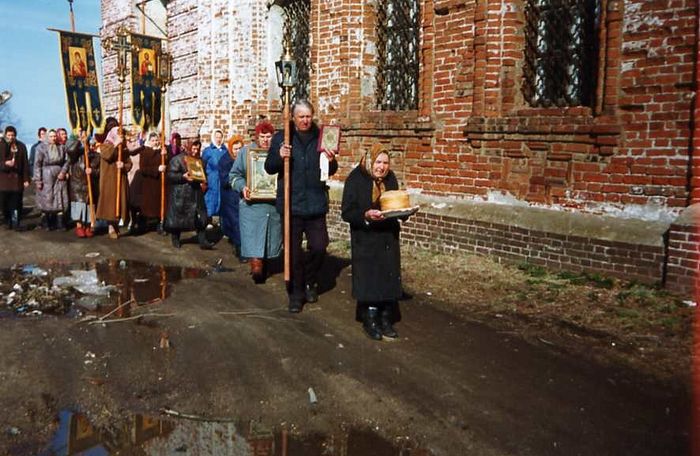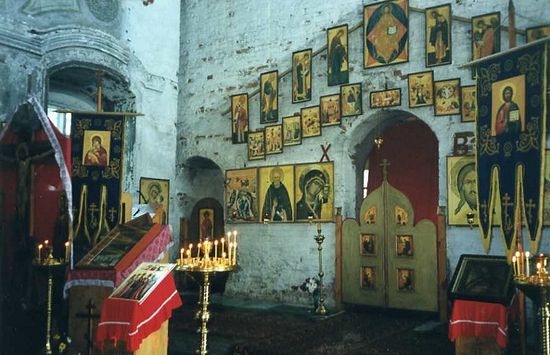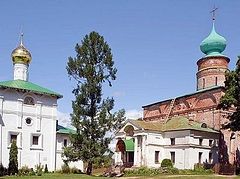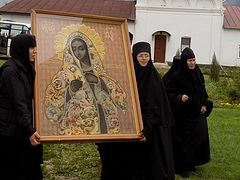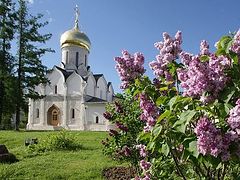 Church of the Forty Martyrs (Pereslavl-Zalessky)
Church of the Forty Martyrs (Pereslavl-Zalessky)
The surface of the narrow ancient River Trubezh is filled with numerous wooden boats, with parishioners and clergy from the surrounding churches; everyone in bright festive vestments with banners and icons in hand; everything shines in the dawn sun; golden reflections disperse on a shallow wave to the shore; there are crowds of people, dressed up, with flowers. At the first stroke of the bell, the boat procession begins its journey.
… Behind another turn in the Trubezh opens the expanse of the wide—as big as the sky—Lake Pleshcheyevo. The cross procession sails between two churches standing on opposite banks of the river. The bell-ringing intensifies. From the memoirs of the Hieromartyr Evgeny of Pereslavl (Elkhovka): “It was a great joy and spiritual pleasure to meet this procession, standing with the cross outside by the porch of the church (I always served in the Church of the Entrance on this day, of the holy Forty Martyrs). How magical this picture seemed to me from a distance! A marvelous living picture!”
This “picture” can still be seen in Pereslavl-Zalessky today, with a few exceptions. It’s no longer as crowded and solemn as before the revolution, when the fishing village celebrated the feast of the Sixth Sunday. It’s been the favorite feast of the locals since the Middle Ages. There are fewer icons now, though someone always has an icon of the Hieromartyr Evgeny (shot in 1937). There’s another difference: Instead of two churches at the mouth there remains only one, of the holy Forty Martyrs. The second was blown up.
But it was precisely with the Church of the Forty Martyrs that the transfiguration of these places began after the fall of the USSR. First the church, then the coast, then the entire city, and then they began to remember the beautiful tradition of the cross procession on the river…
We spoke with the rector, Archpriest John Gerasimov, about how the bells of the “church on the water” again rang out in Pereslavl, about the difficult and unusual history of this church, and about spiritual traditions and the last days.
 Archpriest John Gerasimov with parishioners. Photo: 40s.pereslavl.ru
Archpriest John Gerasimov with parishioners. Photo: 40s.pereslavl.ru
“The enemy took revenge on us for opening the church on Pascha”
When my matushka and I arrived here in the 1990s, the church looked very sad, without any windows, without a door (Batiushka says tenderly, as if about a child). There was a rescue station in the church, but the rescuers didn’t work very hard. Huge trees had grown up in the bell tower—one tree was twenty feet tall. It destroyed the bricks and the walls. And crows were living there (pointing under the dome). I climbed there myself to scrape away the crows’ nest, and it was maybe—you won’t believe this—thirty inches thick, made of wires and dry branches. The crows were flying circles around me, and I was scraping, scraping…
There were several rooms and offices in the altar, and the winter chapel was completely built up. My matushka and I settled in the medical office and lived there for about four years.
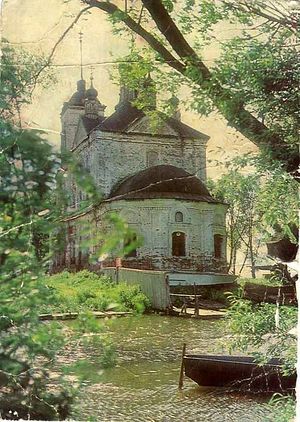 The state of the church when it was transferred to the Church. Photo: 40s.pereslavl.ru I started to read akathists—this was before my ordination—and then molebens. I went to the forest to make money for the roof, and we were allocated a plot outside the city. I got tired, and then came and broke all the partitions here… They gave the rescuers a spot on the other bank, but they weren’t leaving and weren’t leaving, so I started taking their things out myself…
The state of the church when it was transferred to the Church. Photo: 40s.pereslavl.ru I started to read akathists—this was before my ordination—and then molebens. I went to the forest to make money for the roof, and we were allocated a plot outside the city. I got tired, and then came and broke all the partitions here… They gave the rescuers a spot on the other bank, but they weren’t leaving and weren’t leaving, so I started taking their things out myself…
But, of course, the main trouble was the water. Over the course of eighty years, the lake eroded 165 feet off the shore, and the water was already approaching the bell tower. There were only sixteen feet left…
—So, the church could literally float away on the water?
—Yes. I appealed to one mayor, then another, but there was no opportunity to help us. Having prayed, we started to clear the shore from the water ourselves. We cleared sixteen feet, and simply couldn’t do anymore. Then we poured some concrete.
We strengthened and improved more than 100 yards along the coast. Trees used to grow here—they hid the church, and we opened it a little so people could see the church, and could look at the lake from here and rest. I think there’s the best view from this spot! (Here Batiushka pointed to the window, and behind it—wooden boats tap on wooden bridges, saplings incline towards the surface of the water, and pilgrims and tourists stroll along the bank, walking in silence, because words are completely unnecessary here).
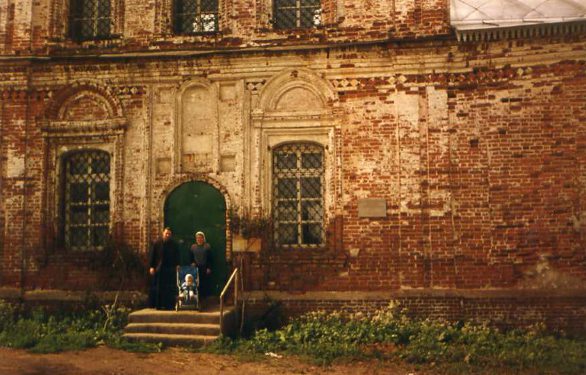 Fr. John and his matushka and child on the porch of the church. Photo: 40s.pereslavl.ru
Fr. John and his matushka and child on the porch of the church. Photo: 40s.pereslavl.ru
—So overall, you brought the grace back to the place; but they say that revenge was taken against you…
—We had our first Paschal service in 1996! Pascha was cold, and we had no heating. Someone advised us to buy a kerosene stove. I bought one, it gave heat, and we warmed up. We served the feast—everything was fine, then, the morning the day after Pascha, I came to serve, and there was so much smoke! I wouldn’t even have been able to see you (I was sitting at arm’s length). And the wind changed, blowing into the chimney, and the stove let out puffs of smoke right into the church. I climbed under the dome. There was a makeshift stairway, I broke the windows, and the smoke hit me! The smoke left before people came, but the smell remained for probably three years. I celebrated the service and gave the cross for people to kiss, and people started inviting me to the bathhouse, as if they’d conspired. One after another said: “Batiushka, I’ll kindle the bathhouse. Come!” I said: “No, no, that’s not necessary. I don’t go to the bathhouse.” I went home and looked in the mirror—I was completely black! It turns out I had served completely black! This is the kind of temptation we had; this is how the enemy took revenge on us for opening the church on Pascha.
But I remember how many people there were then, how joyous and bright the people were, truly feeling that the church was resurrected!
“Maybe it was the dawn before the end”
—They say a lot of people were baptized in your church in those years, nearly all of Pereslavl. Now they come from other cities to get baptized…
—That’s how it turned out. Whether it’s the water that attracts people, or something else, it’s true, very many people have been baptized. I have personally baptized more than 7,000 people since 1995, when I was ordained. Then I started asking other priests to baptize.
—Do they get baptized because the place is beautiful, or do they have comprehension of the Sacrament?
—We have conversations both with those who want to be baptized and with the future Godparents. We talk about God, about faith, about the spiritual life. When you talk, it’s easier to get baptized, and they’re more conscious, with more understanding. Sometimes someone comes to the conversation with completely bored, glassy eyes, a completely heavy appearance, and you start to speak the word of God to him. Half the conversation passes, and you look and his eyes have already lit up. That’s how the word of God works on the soul of man! By the end he’s asking questions.
Here was one case: Two young men and a girl came for a talk, all three of them chewing gum. They sat down in front of me and were chewing. I said: “You have to spit your gum out.” They ran off, spit it out, came back, and looked with stony eyes. It was so difficult for me to speak to these eyes—very difficult! How the world can spoil us! But I started to speak, overcoming myself. And you can’t even imagine how their looks changed after half an hour of our conversation. At the end of the conversation, they were completely different people!
The Lord came so people could change, become better, purer, kinder, and have more love. People stand in church—who are they? Perhaps they’re former murderers, former thieves, fornicators, or adulterers, but the Lord touched their souls, and they began to change. The fornicator is saved from fornication, the proud man from pride, the jealous man from jealousy, the lazy man from laziness, the angry man from anger, the thief from thievery. He discovers the richness and beauty of the spiritual life for himself, and it’s very interesting to observe. If faith doesn’t change anything in a man, then he’s not on the right path. Faith should change a man. It’s the main thing we labor for, why the Church exists.
—They say there’s an impoverishment of faith today. This is especially noticed by those who remember the 1990s—whole cities were baptized then, and hundreds of churches were restored completely selflessly by regular people.
—Maybe it was the dawn before the end. I’m afraid to even talk about what the Fathers spoke about, but it seems to me there was more fire then. I served in a monastery in 1995. I remember young people would come to the monastery, stay to live, and there were absolutely no amenities there. Everything was in ruins, no cells, bare earth… They labored, and more fire could be seen than now. Today there is lukewarmness, which can’t warm you or spark others. A man should burn with love for the Lord. Only this fire is able to light the hearts of others.
—It seems to me today is the time when love is fading away…
—It’s said: And because iniquity shall abound, the love of many shall wax cold (Mt. 24:12). Love is the beginning, middle, and end of our entire spiritual life. We believe in God not because we are obligated to do so; we fast not because we are obligated to fast; we pray not because someone has forced us… Our whole religion is based on love. Everything a man does for the sake of the Lord, he should do out of love. We know there are three types of service to God: The first type of ministry is servile—that is, when a man fears God—fears being thrown into hell, and he tries to fast, to fulfill the commandments, to go to church. The second service is that of a hireling: “Yes Lord, I will fast, I will pray, I will keep Thy commandments, I will go to church, but give something to me too! Grant me drink, food, clothing, health, and health for my children.” And there is also the service of love, like the service of a son to a father: The son loves his father and is afraid to disappoint him in anything, and tries to serve him with love. As the Holy Fathers have said: I no longer fear God, but I love Him. This third service is the most prophetic; but for some reason, people don’t want to approach this service. Everyone should build their relationship with God on the level of love, because God isn’t something soulless—He is alive.
You have to build a living relationship with God, you know. Therefore, I agree that most of all, there is not enough love today. We look at the lawlessness surrounding us, and for some reason our love is diminished; but we mustn’t identify the sinner with the sin. The source of sin comes from the devil, but we should imitate God, our Creator, in humility and in love, and so on. We should hate sin, but love the sinner. I think we need to talk about this virtue in families more. We have to invest a lot in our children, not relying on schools.
“I really wanted to become a priest”
—Did they talk about faith with you in your family?
—Yes, I’m from a faithful Ukrainian family. My grandmother and mother were very faithful, and spoke about God and the spiritual life. These stories really sunk into my soul. Of course, we observed the fasts and we went to church every Sunday, which had a fruitful effect on all of us. There were four children in the family. My mother raised us without a father. Faith has remained with us forever.
—Here I should ask about the main event in your life: How did you become a priest? Because, as far as I understand, you were a jeweler by profession, so you weren’t planning to be a priest…
—I cut diamonds. Imagine—a stone smaller than a match head, and you had to put seventy-five sides on it. It’s precisely this number that gives the diamond its shine, play, and beauty. I was good at it; my matushka and I met at work, and things got even better. One time we went to visit my sister in Sergiev Posad. This was the early 1990s, the beginning of the collapse; it wasn’t clear what was happening in the country, and we found ourselves in the Lavra! My matushka was unchurched then, and she was quite amazed by the Lavra, monasticism, the seminarians… I started telling her what my mother told me about faith, about God, about the good angels, about the evil angels, about the saints, about Paradise, and about hell. She was so penetrated by it that over time, she herself started saying to me: “Let’s go to church, let’s go to church…” Then it so happened that we were offered a job on a state farm for an apartment. The farm was near Sergiev Posad, and we left all our diamonds, moved, got the apartment, worked, helped restore the Theotokos Church, and Matushka started singing on the kliros. Our spiritual development began.
A year and a half later, they offered to make me a priest. This was 1995.
—How did you react to this offer?
—I really wanted to become a priest. I learned to read in the Church of the Theotokos. I would come from work and read the Old Testament readings… But here I have to talk about work on the farm: It was very difficult. At 5:00 you get up for the first milking, which lasts until 7:00; from lunch you go do the milking again, and in the evening, again. And the people there are so kind and simple. When they saw that I go to church, that I’m always praying, they started asking me to bless their apartments. I explained that I wasn’t a priest. Then they started giving me commemoration lists to take to church, and my path was probably already being determined then (laughs).
Matushka and I really wanted to serve God, but we didn’t dare.
Of course, when they offered me, I went to see my spiritual father. He said the priesthood is not sought—the Lord sends it, and we have to receive His will. So, with the blessing of my spiritual father, I left work and went to Pereslavl.
—Why Pereslavl?
—Igumen Anatoly invited us here. Now he’s the bishop of Kostanay and Rudny. He was the abbot of the Pereslavl monasteries then and built the St. Nicholas Monastery near our church. So he brought Matushka and I to this church.
“The icons fell to the ground along the road”
—Let’s return to the church’s dramatic history. I was most struck by how the parishioners fought for their church. They boldly went out to meet the Commission for the Removal of Church Valuables and insisted that they not take the utensils needed for the services out of the church. And the officials listened to them… Tell us about that time.
—I have to start with the fact that Hieromartyr Evgeny (Elkhovsky) served here for twelve years, and then he was transferred to St. Nicholas Monastery. He did a lot of work here. He was very loved. They built a house for him next to the church. His main ministry was in the church across the river, in the Entrance Church, which was blown up. Oh, what a pity! It was such a harmony of beauty! Two churches at the mouth of the river, on both sides of the water… When they blew that one up, they came to blow up ours too. They’d even placed the explosives already, but the local fishermen started asking: “Don’t blow it up. We were married here, baptized, the entire fishing settlement invested its money, made icons, the iconostasis, we did the plastering…”
They even came up with some craftiness: They said, “Leave the church at least as a lighthouse—we can’t see where the mouth of the river is from the lake.” And it’s true—the mouth isn’t visible from the lake. I once swam to the middle, and everything merges from there. And in view of the fishermen’s request, they left the church. They didn’t blow it up. In gratitude, the church’s bell ringer rang the bells for several more years when there was fog, to give the fishermen some orientation, so they could hear where the church was.
After Fr. Evgeny, they appointed Fr. Leonid (Gilyarsovsky), who fought with the Commission for the Removal of Church Values. In those days, he was often dragged around the courts for questioning. Fr. Leonid was shot as an “organizer of an anti-Soviet group of counter-revolutionary clergy.” It occurred on December 10, 1937, a month and a half after they shot Fr. Evgeny. No one served from that point on.
—But, as I understand it, there was a starosta here who became a legend, and he managed to save the church for decades.
—Yes, there was a starosta, the servant of God Peter. He had the keys to the church. And everything in the church—the iconostasis, the vestry, the candlestands—everything remained in the church until 1965—that is, while he was alive. Then the church was opened, and people started running here, and various people plundered the iconostasis. The old-timers remember that someone came on a cart, loaded up the entire iconostasis, and took it away. The icons fell to the ground along the road. I looked in the local museum: There isn’t a single icon from our church; just a rich Gospel and silver censer.
—What else is known about the starosta? Who was he? Why was he able to negotiate with the authorities?
—He was a local fisherman. I saw his photo somewhere. He was an ordinary man. There was a fish farm here, and the starosta also worked selling fish. They say he was very kind. Nothing else is known about him. How he managed to keep everything here is also unknown. I think maybe they served akathists in secret.
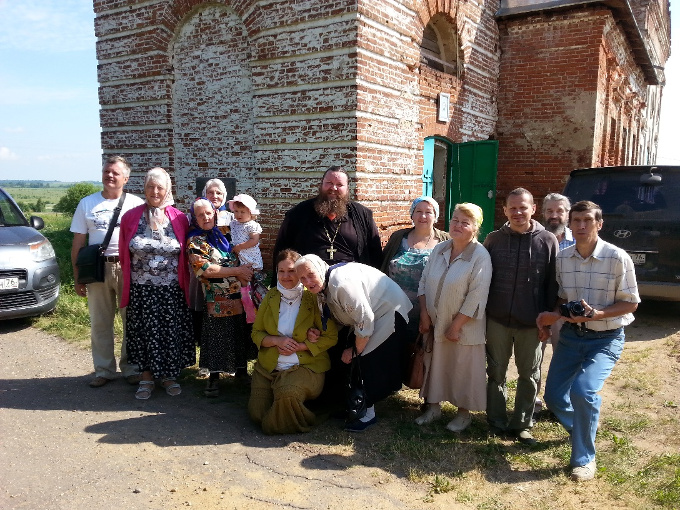 Archpriest John Gerasimov with parishioners. Photo: 40s.pereslavl.ru
Archpriest John Gerasimov with parishioners. Photo: 40s.pereslavl.ru
—I can’t not but ask about the relics, miracles…
—The grace of God is in the fact that a particle of the relics of the Forty Martyrs came to our church, because they are the proprietors of this church. As you know, the Forty Martyrs were always venerated in Rus’. Even in churches of the fifteenth century, we see frescoes of the Forty Martyrs. For example, in the Lavra, in Trinity Cathedral, where the relics of St. Sergius of Radonezh are kept, there is a large fresco of the Forty Martyrs; the church was painted in the first half of the fifteenth century.
—You mentioned the end of the world during our conversation. In your view, are there more and more signs of the end, which the Holy Fathers spoke about?
—We should always watch for signs. The Lord calls us to vigilance: Watch and pray (Mt. 26:41). People have always been expecting the end of the world. They expected it under the Roman emperors, under Napoleon, under Hitler…
From the point of view of Gospel teaching, it’s very good if someone observes the signs. It means he is vigilant. When someone observes the spirit of antichrist in himself, it’s even better, because it lives within us. “Sin,” from the ancient Greek is translated as “missing the mark,” that is, I went afoul, I went the wrong way, I’m walking past God. Sin embroils us; sin makes children quarrel with parents, nations with nations; it gives birth to wars, sometimes even fratricidal wars. Wars are multiplied because sin is multiplied in society; evil and hatred are multiplied. It’s very difficult to eradicate wars in a world without love.
But we have to go deeply into all this, to see sin, to see it within our very selves, to uproot it. The Lord gives us a mind not only to comprehend some things in today’s life, but also to seek Him. The Bible says: Your heart shall live that seek God (Ps. 68:32). To comprehend, to know God—every Christian must take this work upon himself, because otherwise we will be like the fig tree that the Lord cursed. The fig tree was good, the leaves beautiful and lush, the trunk sturdy, the roots strong, but there was no fruit! So a person can have every gift within himself, but not attain the fruits of the Spirit.

